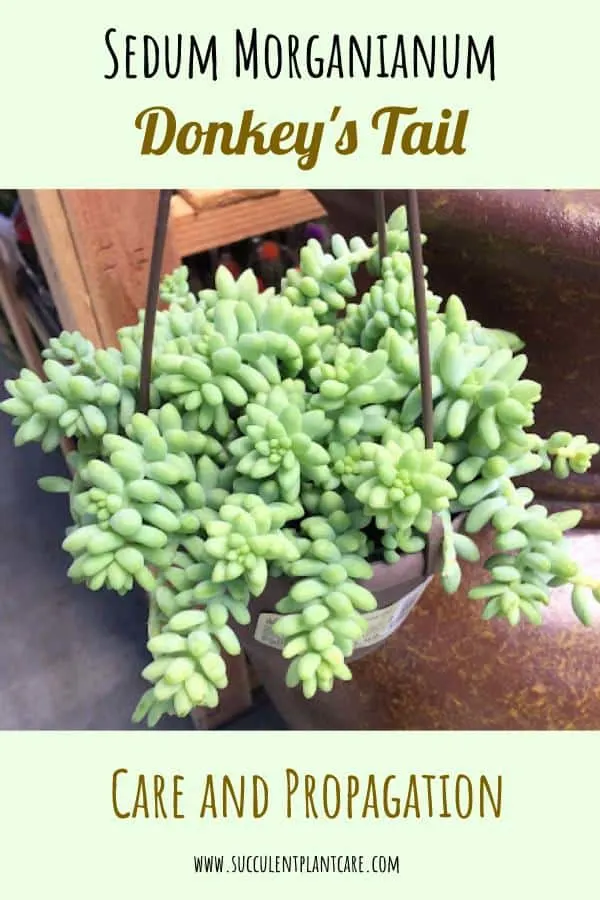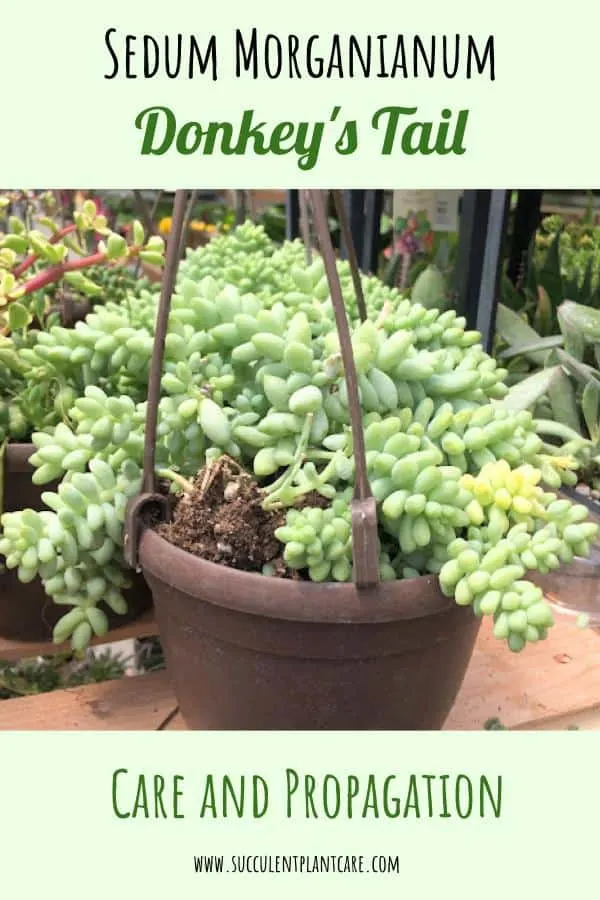Native to Southern Mexico and Honduras, Sedum Morganianum (known by several common names such as Donkey’s Tail, Burro’s Tail, Lamb’s Tail and Horses’ Tail) have adorable, plump little leaves that are lime-green to blue-green in color. The leaves are tightly compacted around the stem. These plants are best known for their unique foliage and trailing stems that can grow up to about 3 ft (91 cm) long or longer.
These are very popular plants used in hanging baskets or as trailing plants in different arrangements. You can often find them dangling or cascading down the sides of the pot or a tall planter. Sedum Morganianum is not hard to grow. Follow these simple guidelines below to keep yours happy.

Is Sedum Morganianum an Indoor or Outdoor Plant?
Sedum Morganianum can be grown both indoors and out, as long as you provide it with sufficient sunlight for it to thrive. It grows best when exposed to plenty of bright sunlight. It will be happiest outdoors where it can receive the brightest light possible, but it can also be grown indoors when given the right conditions.
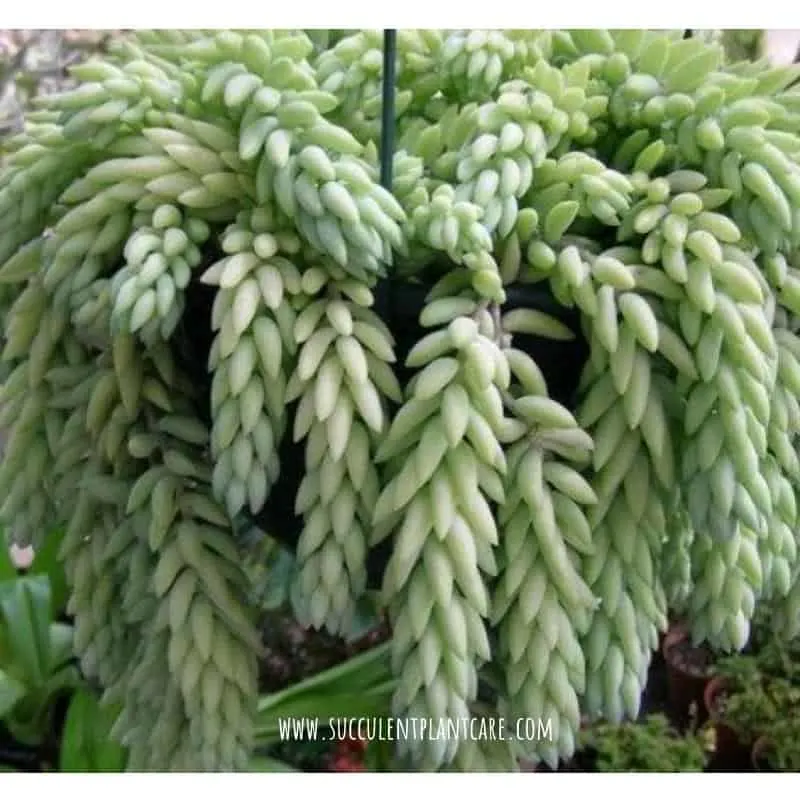
Indoor Lighting Requirements
Find the brightest spot to place your plant. For your plant to survive and thrive indoors, it needs to receive adequate lighting. Choose a south-facing window if possible.
An east or west facing window will also work. Generally speaking, it needs approximately 5-6 hours of bright light per day to thrive. This plant will not do well in a dark, shaded area for too long.
If you live in an area that does not receive adequate light indoors no matter where you place the plant, consider using a grow light. Grow lights are a good investment especially if you have long, dark winters or if your area does not receive enough sunlight. Here are some of my grow light recommendations.
For more on this topic, visit my post on “Proper Lighting For Succulents Indoors”.
Outdoor Sunlight Requirements
Outdoors, place in a bright sunny location. This plant will tolerate light shade to full sun. Before moving the plant outdoors or increasing the amount of sunlight it receives, it is better to acclimate the plant to prevent sunburn.
Slowly increase the amount of light the plant receives to get it acclimated to the more intense light. This will help prevent sunburn or sun damage. Keep in mind that even when the plant is already acclimated to the sun, you still need to provide sun protection or shade during a heatwave or intense heat.
Sunshades are a real lifesaver for my plants during the intense summer heat here in Northern California where the sun can really scorch the plants if left unprotected. Here are some of my recommendations for sunshades and sun protection.
For more on this topic, visit my post on “How Much Sunlight Do Succulents Need Outdoors?”
Frost Tolerance
USDA Hardiness Zone: 10a-11b (30 to 50 °F or -1 to 10 °C)
Sedum Morganianum are not frost tolerant plants and would need protection from freezing temperatures. Where I live here in California, I can keep my Sedum Morganianum outdoors all year long. We do get frost and the temperatures do drop below freezing but not for long periods of time. When there’s prolonged frost expected, I protect my plants or bring them indoors.
If you live in areas with extreme winter conditions, the best way to grow these plants is in containers. That way you can bring them in for the winter to protect them from the freezing temperatures. You can provide your plants with protection from freezing temperatures if kept outdoors by using shade cloths and greenhouses.
These can save your plants and protect them from the long, harsh winter months. Here are some of my frost protection recommendations. For more on this topic, visit my post on “Optimal Temperatures for Succulents to Survive and Thrive.”
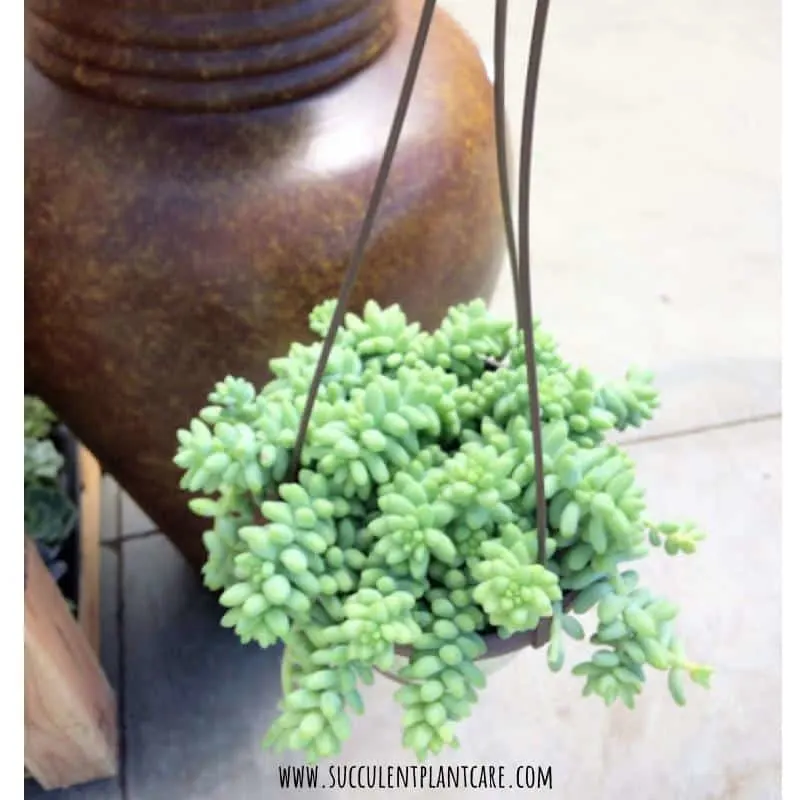
Soil Requirements
Just like with other succulent plants, Sedum Morganianum needs well-draining soil. What I normally do is I use a cactus potting mix and combine it with perlite for added drainage. I do not use exact measurements but eyeball it to about 2:1 solution of cactus mix and perlite.
You can also consider using sandy soil. This can be achieved by mixing cactus mix or potting soil with coarse sand (about 2:1 ratio). I get most of my materials from a local garden center. If there isn’t one near you, check out my resource page for soil and soil amendment recommendations.
To read more on the topic of soil for succulents, visit my post on “Best Soil and Fertilizers for Succulents” for more information.
Watering Requirements
Watering would greatly depend on the climate you live in. There really isn’t a set schedule or formula on when to water succulents. I live in a very dry climate so my watering schedule is adapted to the dry conditions of my environment.
In the summer months, I water my Sedum Morganianum every 7-10 days, sometimes more during a heatwave. I cut back on watering to every 10-14 days when the weather cools down. If you live in a humid location, you won’t need to water as much.
During the winter season, I mostly rely on rainwater and hold back on watering altogether because this is when we get a lot of rain in my area. But if we don’t get any rain at all during winter then I water at least once a month or every 2-3 weeks.
How I water the plant is I give it a good drink and leave it alone until the soil is dry. One good way to tell whether it’s time to water is to check the moisture of the soil. The top inch of the soil needs to feel dry before you can water again.
If you are unsure how much and how often to water in the beginning, it’s always better to underwater and increase watering as needed. Pay attention to how your plant looks and you can adjust watering accordingly. If you need further help with watering techniques, consider using tools like hygrometers or moisture meters to check for moisture in the soil and air.
These tools are pretty affordable and can come in handy especially if you are unsure of when to water your plant next. Here are some of my moisture meter recommendations.
Are You Overwatering or Underwatering?
The best way to tell whether your Sedum Morganianum is over or under watered is by paying attention to how the leaves look. The easiest way to tell if your plant is underwatered is when the leaves start shriveling. When this happens, it is usually a sign that the plant is running low on its water storage and it is time to water.
Simply give the plant a good drink and it should perk up within a few days. On the other hand, if the plant starts looking soft and mushy, looks unwell, and starts dropping leaves at the slightest touch, these are telltale signs that you are overwatering your Sedum Morganianum. These plants have storage capacities in their stems and leaves so they can go for a long time without water, especially mature plants.
If this is the case with your plant, don’t worry. The first thing you need to do is to stop watering your plant. Give it a chance to dry out and the plant will usually bounce back. If the soil is not drying out fast enough and stays wet for long periods of time, it is a good idea to repot the plant in a well draining potting mix.
I always say that It is easier to ‘fix’ an under-watered plant than an overwatered one. To read more on this topic, visit my post on “How To Tell If Your Succulent Is Over or Under Watered”. I also wrote a post on saving an overwatered succulent plant here: “How To Save An Overwatered Succulent Plant.”
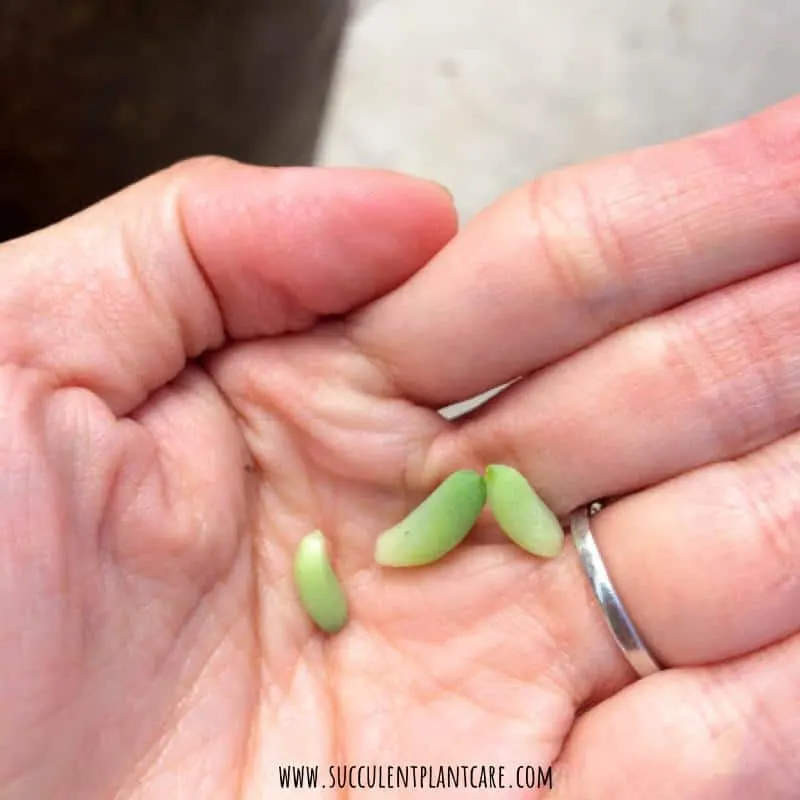
Fallen leaves can be placed back in the pot. Some will root and propagate.
How To Propagate a Sedum Morganianum
The easiest and quickest way to propagate a Sedum Morganianum is through stem cuttings. It can also be propagated through leaves. My preferred route is almost always through stem propagation.
Leaf propagation usually takes longer than stem cuttings and the success rate is not as high (at least for me). But since they drop leaves quite easily, leaf propagation can be a very useful way to multiply these plants.
Propagation steps are as follows:
Step 1: Take a few stem cuttings or leaves. Choose stems or leaves that are plump and healthy, not shriveled or dehydrated. When using leaves, make sure to obtain the whole leaf. A damaged leaf will not work.
Step 2: Let the cuttings dry for a day or so until the cut or wound has healed. Keep in a dry place and away from direct sunlight. (Optional: Dip cuttings in rooting hormone. While not necessary, rooting hormones can help speed up the rooting and propagation process).
Step 3: Prepare a well-draining potting mix. Once dry, stick the stem cuttings in soil. Stick the leaf cuttings in soil or lay them flat on the soil.
Step 4: Wait for the plant to root and new growth to develop. This can take anywhere from 2 weeks or more.
Step 5: Keep away from direct sunlight to prevent sunburn while rooting the cuttings.
Step 6: Water every few days or when the soil feels dry. Once rooted and more established, decrease the frequency of watering to once a week or less. Mature plants have more water storage capacity than baby plants.
Sedum Morganianum Blooms
Sedum Morganianum produces attractive, pink or reddish flowers. These flowers contrast very nicely with the blue-green foliage of the plant, giving it a striking appearance. Seeing these plants bloom is truly a treat. While it is exciting to see them flower, do realize that not all plants will bloom. Environmental factors beyond our control play a huge part in whether or not your plant blooms.
Tips on how to get your Sedum Morganianum to bloom:
Plant Maturity
Make sure the plant is mature enough to bloom. When a plant blooms it means it is ready to reproduce. If the plant is too young, it is simply not ready to reproduce and therefore will not bloom. For a Sedum Morganianum to bloom, it needs to achieve a certain length and maturity. Do not expect a small or young plant to bloom anytime.
Proper Temperatures
To encourage flowering, provide proper temperatures. They need a distinct difference in night and day temperatures as well as summer and winter months. Succulents favor cooler outdoor nighttime temperatures of 50-55⁰F (10-13⁰C) or indoor night temperatures of at least 60-65⁰F(15-18⁰C). Especially when kept in a controlled environment, succulents prefer a marked difference between their night and day temperatures to mimic their natural habitat, with the cool night temperatures having an integral part in the plant’s growth cycle.
Overwintering
Overwintering is also important if you want to see your succulents bloom. This can be achieved by keeping them cool and relatively dry in the winter months, especially desert cacti. Keep them cool during winter months with temperatures just above freezing, between 35-44⁰F (1.5-7⁰C). If kept indoors during winter, have them in a non-heated room if possible or keep the temperatures low to provide them the cold winter period that they need.
Plenty of Light
Make sure the plants are receiving adequate sunlight throughout the year and are kept in a bright location, even during the colder winter months. Most cacti and succulents need at least 5-6 hours of bright light or more.
Feed or Fertilize
While fertilizing is not necessary, giving your plants the nutrients they need will help ensure proper growth and encourage blooms. It takes a lot of energy for plants to produce flowers, and feeding them extra nutrients will help supplement their needs during the flowering season. The most common recommendation is to fertilize during the active growing season, or during spring and summer months.
Fertilizers are better applied at a quarter or half strength, about every two weeks. Refrain from fertilizing towards the end of the fall season and during the winter months. A balanced blend of fertilizer diluted to half strength is suitable and commonly used. Fertilizer blends specially formulated for cacti and succulents are also suitable. Here are my fertilizer recommendations.
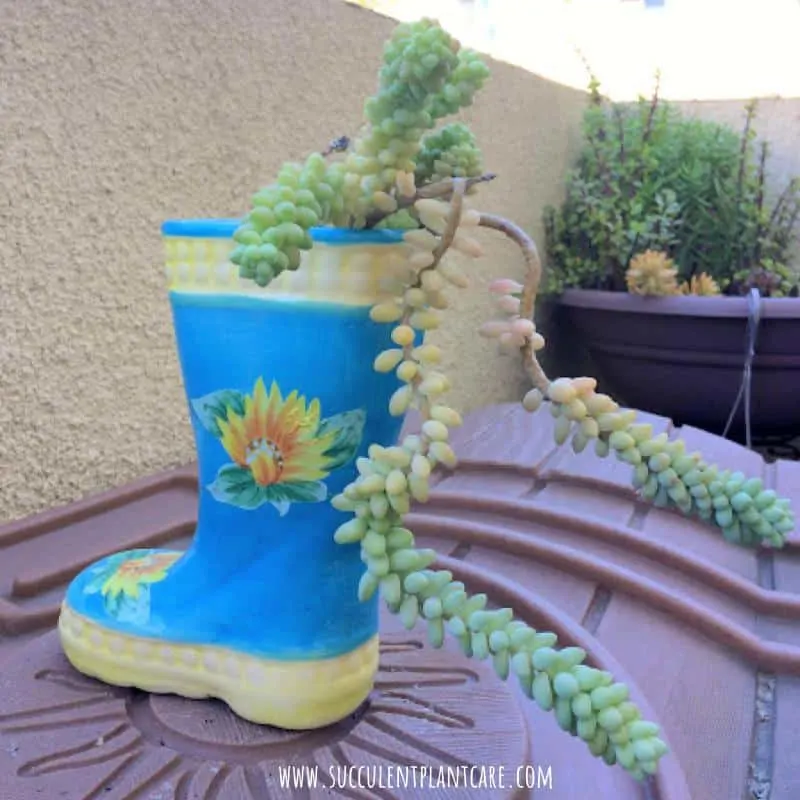
Sedum Morganianum Toxicity to Cats, Dogs or Pets
Sedum Morganianum is non-toxic to cats, dogs or pets according to the ASPCA website. If you suspect poisoning, contact your local veterinarian immediately or the ASPCA Animal Poison Control Center at 888-426-4435.
Despite being such a popular succulent plant, Sedum Morganianum still remains such a fascinating plant because of its uniquely shaped leaves and long, trailing stems. They continue to be one of my all-time favorites.
Wondering where to find Sedum Morganianum? Check out my resource page for recommendations on where to find these and other succulents online.
Pin this to save for later or share with others now!
